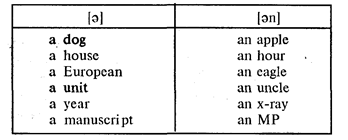Syntactical functions of the noun
§ 185. A noun may be used in the function of almost any part of the sentence, although its most typical functions are those of the subject and the object. It may function as
1. Subject:
The ship got under way.
2. Predicative:
He was certainly the best hated man in the ship.
3. Object:
I gave him a pound. Twelve dollars are enough for the man.
4. Objective predicative:
I found him an excellent listener.
5. Attribute:
A dog is a man’s best friend.
6. Adverbial modifier (usually as part of a prepositional phrase):
High above the city, on a tall column, stood the statue of the Happy Prince.
THE ARTICLE
§ 186. The article is a form word that serves as anoun determiner.It is one of the main means of conveying the idea ofdefiniteness and indefiniteness.
There are two articles in English: the definite articlethe [ði:] and the indefinite article a [ei].
Definiteness suggests that the object presented by the following noun is individualized and singled out from all the other objects of the same kind, whereas indefiniteness means a more general reference to an object. Thus when saying The book is a historical novel or The boy has a dog or The telephone is out of order, the speaker treats the objects book, boy, telephone as specific objects, while saying a dog, a historical novel the speaker characterizes the objects in a more general way, pointing out what kind of novel the book is and what kind of pet animal the boy has.
The notion of definiteness/indefiniteness determines the important role of the article in the process of communication. The definite article usually presents the notion assomething already known, whereas the indefinite article introduces anew item of information. The presentation of objects as definite or indefinite, as already known or as new, depends on the speaker or the writer, who by using articles establishes mutual understanding between the speaker and the listener, the writer and the reader.
Since the article is a noun determiner and the noun is the headword in a noun phrase,the syntactical role of the article consists in marking off a noun or a noun phrase as part of the sentence.
The morphological value of the article lies in indicating the substantivization of other parts of speech, mainly adjectives or participles (see examples 1 and 2 below), also pronouns (examples 3 and 4), adverbs (example 5), numerals (example 6):
1. More nurses were required to tend the sick and the wounded.
2. Her hair was a bright brown.
3. It wasn’t a he.
4. He is such a nothing.
5 . There is a Beyond.
6. She was only just fifty and looked a handsome thirty-five.
Both articles have originated from notional parts of speech, whose influence may be traced in their meaning and use.
The definite article developed from a demonstrative pronoun, which accounts for its meaning of definiteness. The demonstrative force remains in many phrases, such as at the time, of the kind, in its use before restrictive attributes, and in some situational uses.
The indefinite article developed from the cardinal numeral one, The numerical meaning is evident in such phrases and sentences as at a time, in a moment, wait a minute, not a sound was heard.
The pronunciation of the articles and the spelling of the indefinite article depend upon the initial sound of the following word. The indefinite article is spelled as a before consonant and asan before vowel sounds. When stressed it is pronounced respectively as [eɪ] or [æn]. However, since the articles are usually unstressed, the pronunciation of the indefinite article is generally reduced to the neutral vowel [ǝ] before consonants, and to [ǝn] before vowel sounds, which depends entirely on the pronunciation and not the spelling of the following word, as can be seen in the table below.

The definite article is pronounced as [ði:] when stressed. When unstressed, it is pronounced as [ðǝ] before consonants and [ðɪ] before vowels:
| [ðǝ] | [ðɪ] |
| the dog the house the European the unit the manuscript | the apple the hour the x-ray the uncle the MP |
Since the article is the opening element of a noun phrase, it is placed before the noun it refers to or before all the other noun premodifiers. The exceptions to this rule are as follows:
a) the definite article may be preceded by the predeterminers alt and both:
Are you going to cook all the cakes yourself?
Both the answers were good.
b) the indefinite article may be preceded by the predeterminers what, such, quite:
What a sight I am in this hat!
You were such a queen, and I was such a nothing!
You are quite a scholar.
с) the indefinite article is placed after adjectives preceded by the adverbs too, as, so:
That was too difficult a problem for the child to solve.
It’s as good an excuse as any for breaking it up.
I’ve never seen so miserable a creature as Jane was at the moment.
